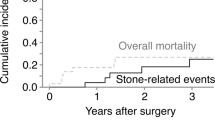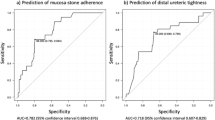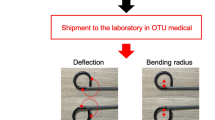Key Points
-
Use of flexible ureteroscopy (URS) for treating patients with kidney stones has increased compared with shockwave lithotripsy and percutaneous nephrolithotomy
-
Wide variations in use, and timing of postoperative imaging as well as definitions of stone-free rate (SFR) make accurate assessments of stone clearance after flexible URS challenging
-
CT provides the most accurate way to assess the presence of residual fragments; however, even when retrieval of fragments is employed, the complete SFR might only approach 55–60%
-
At the minimum, SFRs should report the zero-fragment rate; residual fragment size >2 mm is associated with significantly increased risk of a stone-related event and greater need for retreatment
-
Treatment of patients with lower-pole stones using a basket displacement technique can result in higher SFRs
-
Patients with larger stones receiving treatment with flexible URS might require staged procedures, especially if the cumulative stone size exceeds 1.5–2 cm
Abstract
Flexible ureteroscopy (URS) is increasingly being used as the first-line treatment for patients with renal stones. Despite this increase in use, substantial variations exist in the reported stone-free rates (SFR) following flexible URS. These variations are a result of inconsistencies in the definition of 'stone-free', which reflect variations in the type of imaging used to assess the presence of stones postoperatively and the timing of the assessment. Other possible factors such as the importance of residual fragments following stone surgery, and the size and position of the stones might also account for variations in stone-free rates. In order to obtain an accurate estimate of the SFR, especially within subgroups defined by stone characteristics and exact technique, we compare reported SFRs from studies that use imaging other than CT for follow-up and those that use only CT. We also review the evidence on the importance of active retrieval of fragments during flexible URS and whether this technique improves the outcomes of patients with kidney stones.
This is a preview of subscription content, access via your institution
Access options
Subscribe to this journal
Receive 12 print issues and online access
$209.00 per year
only $17.42 per issue
Buy this article
- Purchase on Springer Link
- Instant access to full article PDF
Prices may be subject to local taxes which are calculated during checkout
Similar content being viewed by others
Change history
15 February 2016
In the author line of the originally published article, the full initials of J. Stuart Wolf Jr were not included. Also, in the footnote of Table 2, "*Pre-operative stents present in all patients" should read "*Post-operative stents present in all patients". These errors have been corrected for the HTML and PDF versions of the article.
References
Litwin, M. S. & Saigal, C. (Eds.) Urologic Diseases in America (US Government Printing Office, 2012).
Scales, C. D. Jr, Smith, A. C., Hanley, J. M. & Saigal, C. S. P. Prevalence of kidney stones in the United States. Eur. Urol. 62, 160–165 (2012).
Taylor, E. N., Stampfer, M. J. & Curhan, G. C. Obesity, weight gain, and the risk of kidney stones. JAMA 293, 455–462 (2005).
Abate, N., Chandalia, M., Cabo-Chan, A. V. Jr, Moe, O. W. & Sakhaee, K. The metabolic syndrome and uric acid nephrolithiasis: novel features of renal manifestation of insulin resistance. Kidney Int. 65, 386–392 (2004).
Ghani, K. R. et al. Trends in surgery for upper urinary tract calculi in the USA using the Nationwide Inpatient Sample: 1999–2009. BJU Int. 112, 224–230 (2013).
Lee, M. C. & Bariol, S. V. Evolution of stone management in Australia. BJU Int. 108, S29–S33 (2011).
Ordon, M. et al. The surgical management of kidney stone disease: a population-based time series analysis. J. Urol. 192, 1450–1456 (2014).
Goldsmith, Z. G. & Lipkin, M. E. When (and how) to surgically treat asymptomatic renal stones. Nat. Rev. Urol. 9, 315–320 (2012).
Edvardsson, V. O., Indridason, O. S., Haraldsson, G., Kjartansson, O. & Palsson, R. Temporal trends in the incidence of kidney stone disease. Kidney Int. 83, 146–152 (2013).
Boyce, C. J., Pickhardt, P. J., Lawrence, E. M., Kim, D. H. & Bruce, R. J. Prevalence of urolithiasis in asymptomatic adults: objective determination using low dose noncontrast computerized tomography. J. Urol. 183, 1017–1021 (2010).
Scales, C. D. Jr et al. Practice variation in the surgical management of urinary lithiasis. J. Urol. 186, 146–150 (2011).
Matlaga, B. R. & the American Board of Urology. Contemporary surgical management of upper urinary tract calculi. J. Urol. 181, 2152–2156 (2009).
Lingeman, J. E. et al. Extracorporeal shock wave lithotripsy: the Methodist Hospital of Indiana experience. J. Urol. 135, 1134–1137 (1986).
Streem, S. B., Yost, A. & Mascha, E. Clinical implications of clinically insignificant store fragments after extracorporeal shock wave lithotripsy. J. Urol. 155, 1186–1190 (1996).
Lipkin, M. E. & Preminger, G. M. Imaging techniques for stone disease and methods for reducing radiation exposure. Urol. Clin. North Am. 40, 47–57 (2013).
Acar, C. & Cal, C. Impact of residual fragments following endourological treatments in renal stones. Adv. Urol. 2012, 813523 (2012).
Rebuck, D. A., Macejko, A., Bhalani, V., Ramos, P. & Nadler, R. B. The natural history of renal stone fragments following ureteroscopy. Urology 77, 564–568 (2011).
Raman, J. D. et al. Natural history of residual fragments following percutaneous nephrostolithotomy. J. Urol. 181, 1163–1168 (2009).
Osman, Y. et al. Clinically insignificant residual fragments: an acceptable term in the computed tomography era? Urology 81, 723–726 (2013).
Hyams, E. S., Bruhn, A., Lipkin, M. & Shah, O. Heterogeneity in the reporting of disease characteristics and treatment outcomes in studies evaluating treatments for nephrolithiasis. J. Endourol. 24, 1411–1414 (2010).
Portis, A. J. et al. Retreatment after percutaneous nephrolithotomy in the computed tomographic era: long-term follow-up. Urology 84, 279–284 (2014).
Perlmutter, A. E. et al. Impact of stone location on success rates of endoscopic lithotripsy for nephrolithiasis. Urology 71, 214–217 (2008).
Breda, A., Ogunyemi, O., Leppert, J. T. & Schulam, P. G. Flexible ureteroscopy and laser lithotripsy for multiple unilateral intrarenal stones. Eur. Urol. 55, 1190–1196 (2009).
Cansino Alcaide, J. R. et al. Flexible ureterorenoscopy (URS): technique and results. Arch. Esp. Urol. 63, 862–870 (2010).
Wendt-Nordahl, G., Mut, T., Krombach, P., Michel, M. S. & Knoll, T. Do new generation flexible ureterorenoscopes offer a higher treatment success than their predecessors? Urol. Res. 39, 185–188 (2011).
Herrera-Gonzalez, G., Netsch, C., Oberhagemann, K., Bach, T. & Gross, A. J. Effectiveness of single flexible ureteroscopy for multiple renal calculi. J. Endourol. 25, 431–435 (2011).
Schoenthaler, M. et al. Retrograde intrarenal surgery in treatment of nephrolithiasis: is a 100% stone-free rate achievable? J. Endourol. 26, 489–493 (2012).
Miernik, A. et al. Standardized flexible ureteroscopic technique to improve stone-free rates. Urology 80, 1198–1202 (2012).
Ito, H. et al. The most reliable preoperative assessment of renal stone burden as a predictor of stone-free status after flexible ureteroscopy with holmium laser lithotripsy: a single-centre experience. Urology 80, 524–528 (2012).
Berquet, G., Prunel, P., Verhoest, G., Mathieu, R. & Bensalah, K. The use of a ureteral access sheath does not improve stone-free rate after ureteroscopy for upper urinary tract stones. World J. Urol. 32, 229–232 (2014).
Pearle, M. S. et al. Prospective randomized trial comparing shock wave lithotripsy and ureteroscopy for lower pole caliceal calculi 1 cm or less. J. Urol. 179, S69–S73 (2008).
Portis, A. J., Rygwall, R., Holtz, C., Pshon, N. & Laliberte, M. Ureteroscopic laser lithotripsy for upper urinary tract calculi with active fragment extraction and computerized tomography followup. J. Urol. 175, 2129–2133 (2006).
Cocuzza, M. et al. Outcomes of flexible ureteroscopic lithotripsy with holmium laser for upper urinary tract calculi. Int. Braz. J. Urol. 34, 143–149 (2008).
Macejko, A. et al. Computed tomography-determined stone-free rates for ureteroscopy of upper-tract stones. J. Endourol. 23, 379–382 (2009).
Hussain, M., Acher, P., Penev, B. & Cynk, M. Redefining the limits of flexible ureterorenoscopy. J. Endourol. 25, 45–49 (2011).
Resorlu, B., Unsal, A., Gulec, H. & Oztuna, D. A new scoring system for predicting stone-free rate after retrograde intrarenal surgery: the “resorlu-unsal stone score”. Urology 80, 512–518 (2012).
Rippel, C. A. et al. Residual fragments following ureteroscopic lithotripsy: incidence and predictors on postoperative computerized tomography. J. Urol. 188, 2246–2251 (2012).
Ito, H. et al. Development and internal validation of a nomogram for predicting stone-free status after flexible ureteroscopy for renal stones. BJU Int. 115, 446–451 (2014).
Türk C. et al. Guidelines on urolithiasis. Uroweb—European Association of Urology [online].
Grasso, M., Conlin, M. & Bagley, D. Retrograde ureteropyeloscopic treatment of 2 cm or greater upper urinary tract and minor Staghorn calculi. J. Urol. 160, 346–351 (1998).
El-Anany, F. G., Hammouda, H. M., Maghraby, H. A. & Elakkad, M. A. Retrograde ureteropyeloscopic holmium laser lithotripsy for large renal calculi. BJU Int. 88, 850–853 (2001).
Monga, M. et al. Ureteral access for upper urinary tract disease: the access sheath. J. Endourol. 15, 831–834 (2001).
Ricchiuti, D. J. et al. Staged retrograde endoscopic lithotripsy as alternative to PCNL in select patients with large renal calculi. J.Endourol. 21, 1421–1424 (2007).
Breda, A., Ogunyemi, O., Leppert, J. T., Lam, J. S. & Schulam, P. G. Flexible ureteroscopy and laser lithotripsy for single intrarenal stones 2 cm or greater--is this the new frontier? J. Urol. 179, 981–984 (2008).
Riley, J. M., Stearman, L. & Troxel, S. Retrograde ureteroscopy for renal stones larger than 2.5 cm. J. Endourol. 23, 1395–1398 (2009).
Hyams, E. S., Munver, R., Bird, V.G., Uberoi, J. & Shah, O. Flexible ureterorenoscopy and holmium laser lithotripsy for the management of renal stone burdens that measure 2 to 3 cm: a multi-institutional experience. J. Endourol. 24, 1583–1588 (2010).
Bader, M. J. et al. Efficacy of retrograde ureteropyeloscopic holmium laser lithotripsy for intrarenal calculi >2 cm. Urol. Res. 38, 397–402 (2010).
Takazawa, R., Kitayama, S. & Tsujii, T. Successful outcome of flexible ureteroscopy with holmium laser lithotripsy for renal stones 2 cm or greater. Int. J. Urol. 19, 264–267 (2012).
Akman, T. et al. Comparison of percutaneous nephrolithotomy and retrograde flexible nephrolithotripsy for the management of 2–4 cm stones: a matched-pair analysis. BJU Int. 109, 1384–1389 (2012).
Al-Qahtani, S. M., Gil-Deiz-de-Medina, S. & Traxer, O. Predictors of clinical outcomes of flexible ureterorenoscopy with holmium laser for renal stone greater than 2 cm. Adv. Urol. 2012, 543537 (2012).
Cohen, J., Cohen, S. & Grasso, M. Ureteropyeloscopic treatment of large, complex intrarenal and proximal ureteral calculi. BJU Int. 111, E127–E131 (2013).
Miernik, A. et al. Combined semirigid and flexible ureterorenoscopy via a large ureteral access sheath for kidney stones >2 cm: a bicentric prospective assessment. World J. Urol. 32, 697–702 (2014).
Wong, M. Y. Flexible ureteroscopy is the ideal choice to manage a 1.5 cm diameter lower-pole stone. J. Endourol. 22, 1845–1846 (2008).
Elbahnasy, A. M. et al. Lower caliceal stone clearance after shock wave lithotripsy or ureteroscopy: the impact of lower pole radiographic anatomy. J. Urol. 159, 676–682 (1998).
Ghani, K. R., Bultitude, M., Hegarty, N., Thomas, K. & Glass, J. Surgery Illustrated—focus on details flexible ureterorenoscopy (URS) for lower pole calculi. BJU Int. 110, 294–298 (2012).
Bach, T., Geavlete, B., Herrmann, T. R. & Gross, A. J. Working tools in flexible ureterorenoscopy—influence on flow and deflection: what does matter? J. Endourol. 22, 1639–1643 (2008).
Kourambas, J., Delvecchio, F. C., Munver, R. & Preminger, G. M. Nitinol stone retrieval-assisted ureteroscopic management of lower pole renal calculi. Urology 56, 935–939 (2000).
Schuster, T. G., Hollenbeck, B. K., Faerber, G. J. & Wolf, J. S. Jr. Ureteroscopic treatment of lower pole calculi: comparison of lithotripsy in situ and after displacement. J. Urol. 168, 43–45 (2002).
El-Nahas, A. R., Ibrahim, H. M., Youssef, R. F. & Sheir, K. Z. Flexible ureterorenoscopy versus extracorporeal shock wave lithotripsy for treatment of lower pole stones of 10–20 mm. BJU Int. 110, 898–902 (2012).
Singh, B. P. et al. Retrograde intrarenal surgery vs extracorporeal shock wave lithotripsy for intermediate size inferior pole calculi: a prospective assessment of objective and subjective outcomes. Urology 83, 1016–1022 (2014).
Kourambas, J., Byrne, R. R. & Preminger, G. M. Does a ureteral access sheath facilitate ureteroscopy? J. Urol. 165, 789–793 (2001).
Schatloff, O., Lindner, U., Ramon, J. & Winkler, H. Z. Randomized trial of stone fragment active retrieval versus spontaneous passage during holmium laser lithotripsy for ureteral stones. J. Urol. 183, 1031–1035 (2010).
Sanguedolce, F. et al. Use of flexible ureteroscopy in the clinical practice for the treatment of renal stones: results from a large European survey conducted by the EAU Young Academic Urologists-Working Party on Endourology and Urolithiasis. Urolithiasis 42, 329–334 (2014).
Kronenberg, P. & Traxer, O. Update on lasers in urology 2014: current assessment on holmium:yttrium-aluminium-garnet (Ho:YAG) laser lithotripter settings and laser fibres. World J. Urol. http://dx.doi.org/10.1007/s00345-014-1395-1 (2014).
Hecht, S. L. & Wolf, J. S. Jr. Techniques for holmium laser lithotripsy of intrarenal calculi. Urology 81, 442–445 (2013).
Traxer, O. & Thomas, A. Prospective evaluation and classification of ureteral wall injuries resulting from insertion of a ureteral access sheath during retrograde intrarenal surgery. J. Urol. 189, 580–584 (2013).
Author information
Authors and Affiliations
Contributions
K.R.G. researched data for the article, K.R.G. and J.S.W. made a substantial contribution to discussion of content, K.R.G. wrote the article, K.R.G. and J.S.W. reviewed and edited the manuscript before subsmission.
Corresponding author
Ethics declarations
Competing interests
K.R.G. declares that he has acted as a consultant for Boston Scientific and Lumenis. J.S.W. declares no competing interests.
Rights and permissions
About this article
Cite this article
Ghani, K., Wolf, J. What is the stone-free rate following flexible ureteroscopy for kidney stones?. Nat Rev Urol 12, 281–288 (2015). https://doi.org/10.1038/nrurol.2015.74
Published:
Issue Date:
DOI: https://doi.org/10.1038/nrurol.2015.74
This article is cited by
-
Comparison of novel flexible and traditional ureteral access sheath in retrograde intrarenal surgery
World Journal of Urology (2024)
-
Efficacy and safety of minimally invasive percutaneous nephrolithotomy versus retrograde intrarenal surgery in the treatment of upper urinary tract stones (> 1 cm): a systematic review and meta-analysis of 18 randomized controlled trials
BMC Urology (2023)
-
A magnetic hydrogel for the efficient retrieval of kidney stone fragments during ureteroscopy
Nature Communications (2023)
-
Optimal placement of flexible ureteral access sheath in retrograde intrarenal surgery
Urolithiasis (2023)
-
Residual fragment size following retrograde intrarenal surgery: a critical evaluation of related variables
Urolithiasis (2023)



